United Digital Museum, Myanmar (Burma)
Largest Gilded Building
- Details
- Hits: 3535
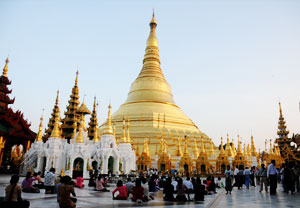
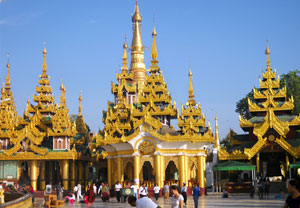 Largest Gilded Building
Largest Gilded Building
Largest Gilded Building is Shwedagon Pagoda.The most notable building in Yangon is the Shwedagon Pagoda. a great cone-shaped Buddhist monument that crowns a hill about one mile north of the Cantonment. The pagoda itself is a solid brick stupa (Buddhist reliquary) that is completely covered with gold. It rises 326 feet (99 m) on a hill 168 feet (51 m) above the city.
Structure
The perimeter of the base of the Pagoda is 1.420 fee and its height 326 feet above the platform. The base is surrounded by 64 small pagodas with four larger. one in the center of each side.
There also are 4 sphinxes. one at each corner with 6 leogryphs. 3 on each side of them. Projecting beyond the base of the Pagoda. one on the cener of each side are Tazaungs in which are images of the Buddha and where offerings are made.
There are also figures of elephants crouching and men kneeling. and pedestals for offerings all around the base. In front of the 72 shrines surrounding the base of the Pagoda. you will find in several places images of lions. serpents. ogres. yogis. spirits. or Wathundari (Recording Secretary Angel).
On the wall below the first terrace of the Pagoda at the WSW and WNW corners. you will see embossed figures. The former represents King Okkalapa who first built the Pagoda. The latter is a pair of figures; the one above represents Sakka who assisted in foundation of the Pagoda. and the one below. Me Lamu. consort of Sakka and mother of Okkalapa.
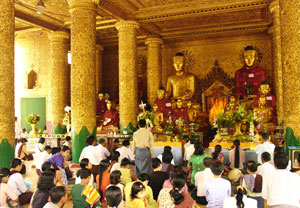
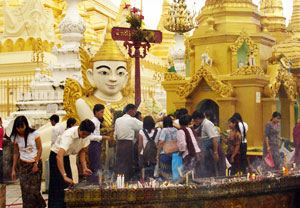
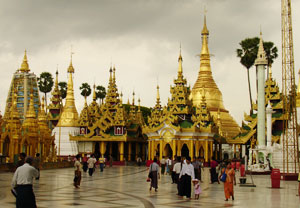

Tunnels
There are 4 entrances leading into the base of this great Shwe Dagon Pagoda. No one is sure what is inside. According to some legendary tales. there are flying and turning swords that never stop. which protect the pagoda from intruders; some says there are even underground tunnels that leads to Bagan and Thailand!
The 10 Parts of Shwe Dagon Pagoda
The Diamond Bud (Sein-phoo)
- The Vane
- The Crown (Htee)
- The Plantain Bud-Shaped Bulbous Spire (Hnet-pyaw-phu)
- The Ornamental Lotus Flower (Kyar-lan)
- The Embossed Bands (Bang-yit)
- The Inverted Bowl (Thabeik)
- The Bell (Khaung-laung-pon)
- The 3 Terraces (Pichayas)
- The Base
Table of Contents on Each Parts
- Part Diamond Gold Precious Stones
- Bud 4.350 pieces. weighing 2.000 ratis
- 9.272 plates of 1 foot square. weighing 5004 ounces 93 pieces
- Vane 1.090 pieces. weighing 240 ratis 1.338 pieces
- Crown 1.065 gold bells 886 pieces
The Gold Plating of the Pagoda
In order to make the gilding stand the weather. the Trustees after the year 1900. decided to cover the bulbous spire. called the plantain bud with gold plates. each plate measuring 1 foot square and weighing 5 ticals of gold (0.18 pound). Subscriptions were called for and the work commenced in 1903. when the whole plantain bud was covered. It is on record that 4 such gold plates were donated by the late King George. V (then Price of Wales) and Queen Mary when they visited Myanmar in 1906.
Background History
Legend has it that Tapussa and Bhallika brought the original sacred hairs of Buddha from India across the ocean. On their way to Myanmar. the two brothers were relieved of 2 hairs by the King of Ajetta. and 2 more were robbed by the King of Nagas. who transformed himself into the likness of a human being and boarded the ship at night.
On arrival in Myanmar. a great festival was celebrated in honour of the sacred hairs for several days. Sakka. Lord of the Heaven. came down to earth and assisted in the selection of the site; but he had to invoke the aid of the 4 apirits: Sule. Amyitha. Yawhani. and Dakkhina.
Relices of the 3 proceding Buddhas were exacavated under their direction in one spot. and were buried there again along with the sacred hairs brought by the 2 brothers. Before placing them in the vault dug on the hill. King Okkalapa opened the casket containing the hairs of instead of 4. 8 hairs flew up to the height of seven palm trees emitting rays of variegated hues with such a dazzle that the dumb could speak. the deaf could hear. and the lame could walk. and a rain of jewels fell knee-deep. A golden stone slab was placed on top of the vault by Sakka and on it was erected a golden pagoda enclosed within silver. tin. copper. lead. marble. and iron brick pagodas up to a height of 66 feet.
Up to the 14th century. not much was known of the Pagoda. In AD 1372. Binnya U. King of Hantharwaddy (Bago) visited Yangon in state the repaired the Pagoda. Successive Kings of Myanmar repaired or re-gilt it till the Shwe Dagon reached its present size some 5 centuries ago.
The little town of Okkala has since grown into the city of Yangopn. but it has no greater glory than the gleaming golden shrine. the spire of which rises majetically into the sky as if conscious of the veneration which the pagoda invokes. The Shwe Dagon apparently begain to assume its importance as a place of religious verneation during the years of the Mon Kingdom of Bago roughly coinciding with the reigns of Binnya U. Binnya Dammayaza. Binnyaran. Binnyawaru. and Binnyagyan. But it was in the time of Queen Shin Sawpu that it first assumed something of its present shape and appearance. Shinsawpu. Queen Regnant of Hantharwaddy. during 1455-62 improved the pagoda. for which she built the terrace. the great balustrade and the several encircling walls. and dedicated a vast area of blebe lands. She gilded the pagoda from top to bottom with gold leaves equal to her body weight. She set up a town on the northwest of the pagoda in the locality now known as Myenigone. so that she might supervise all the works of merit at the pagoda. Her brother and immediate predecessor Binnyagyan had raised the pagoda to to a height of 302 feet.
King Dhamazedi. Shinsawpu's son-in-law and successor. erected inscriptions relating the legend of teh foundation of the pagoda. He also offered a great bell said to weigh 180.000 viss (648.000 lb) of bronze. which the Poruguese adventurer. Phillippe de Brito removed around 1608. so that he might cast the bronze into cannons. The great bell was named Dhamazedi Bell and it really is the largest bell in the whole world. But on the way to Than Lyin (Syriam). of which he was the lord. the boat bearing the great bell sank in the river.
The Pagoda was reverenced by Bayinnaung. his son Nandabayin. Anaukpetlun. Minredeippa. and Tharlun. King Alaungphayar worshipped at the Shwe Dagon and embellished it by re-gilding. Shinbyushin. King of Ava. raised the pagoda to its present height in 1774 and made a new crown (Htee) for it gilding it with his own body weight in gold. King Singu. son of Sinbyushin. in 1778 regilt the pagoda again. and cast a bell which weighed 55.555 viss (~16 tons) of bronze. It stands at the north-west corner of the pagoda platform.
After the First Anglo-Burman War of 1824. this bell was taken by the Prize Agents. but it sank to the bottom of the river and was refloated and replaced at the pagoda by the Myanmar public. King Tharrawaddy in 1841 set up a town on the west side of the pagoda. regilt it with 12 viss (~20 lb) of pure gold and cast a bell 26.000 viss (~40 tons). It stands at the north-east corner of the platform.
King Mindon. who founded Mandalay in 1857. sent down a new golden crown by a steamer to Yangon in October 1871. when Lower Myanmar was already under the British rule. In 1919 there was an earthquake and the Trustees repaired the diamond bud. and vane and replaced them in two years later at a cost of a million rupees.
The pagoda has stood ravages of time and the inclemencies of the weather. having been afflicted with earthquakes on no less than 8 times in 1564. 1628. 1649. 1661. 1664. 1769. 1888. and 1919. and with a serious fire in 1931. It still looks sombre and majestic and perhaps you will agree with Ralph Fitch. who says "It is the fairest place. as I suppose. that is in the world."





